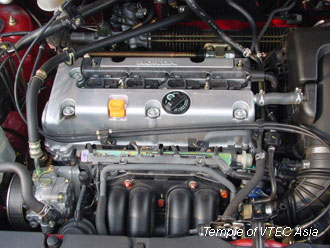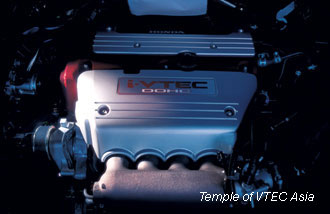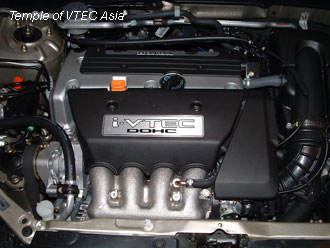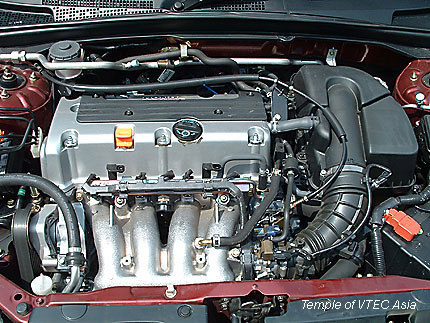

The engine is the heart of a car and so we focus first on the engine bay of the HMRT MME Civics. As far as the engine is concerned, item 3 of the 2004 MME Supplementary Technical Regulations states that 'Engine as supplied in the respective model may be modified, provided that the original intake manifold and throttle body or carburettors are used.'. So this means that the engine used in the race car must be the same series as that used on the road-car from which the race car is built. This rule is very crucial for the eligibility of Civic 2.0 i-VTEC in the MME.
 'Export' Accord 2.0l  CR-V/Stream  Accord/Torneo Euro-R  Civic 2.0 i-VTEC/Type-R |
The HMRT MME winning Civics uses the highly regarded K20A DOHC i-VTEC engine. This is the same base engine that is used on the Civic 2.0 i-VTEC road-car. In its most basic form, all the differences between the street engine and the race engine is their specs and level of tuning, which both the FIA Article 255 and MME ATR allows a lot of freedom. How wild the tuning goes is of course limited by the necessity for the engine to last 12-hours of continuous racing, from 10am in the morning through the highly stressful mid-day till 10pm at night. In a way, it is really correct to say that the MME K20A is the street K20A rebuilt for racing 'twice'. Let me explain what this statement means.
The actual base engine used is the R -spec K20A as used on the famous Type-R cars, in this case more specifically that from the DC5 Integra Type-R. We can actually look at this engine as a derivative of the same K20A engine used on the Civic 2.0 i-VTEC. Historically, the K20A engine was first used on the 2.0l Honda Stream way back in October 2000. TOVA actually translated the official Honda announcement of this engine as well as it's specs and usage in the Stream back then, the translation and our coverage being available in our i-VTEC article. A short while later, Honda published a technical overview of this engine on its official Japan web-site. Again TOVA published an english translation which included additional comments from us in our K20A article. As can be seen from both articles, the original K20A engine, the 'ancestor' so to speak, is an intake-only VTEC implementation, with 3 lobes on the intake cams allowing a 12V low-cam and 16V wild-cam mode. This engine also uses the dual runner intake manifold. Engine power was 154ps.
The DC5 Integra Type-R was launched by Honda on July 2001 and introduced to us the K20A Spec R (what we like to shorten to simply 'K20A-R' though of course such an engine code does not exist). This K20A-R uses VTEC on both intake and exhaust sides with 'full-time' 16V and VTEC changing between mild cam and wild cam for both intake and exhaust. There are of course many other areas of the engine that are different - valve springs rated to higher rpms, different (higher compression) pistons, crank, etc. But the gist is the two engines, the regular intake-only VTEC K20A and the racey K20A-R are really two different derivatives of the same basic engine, and the milder version was actually the first K20A engine used.
Honda also uses several quite different intake manifold designs for different applications of their K20A engines (for different models). The Stream and CR-V for e.g. uses a dual runner design but the 2.0 i-VTEC Accords uses a single runner design tuned for low end torque. Even the red-topped R-Spec K20As have more than 1 intake manifold design, the DC5 ITR and EP3 CTR for e.g. using a different design compared to the CL7 Accord and Torneo Euro-R. In this instance, the Civic 2.0 i-VTEC actually uses the same intake manifold design as the DC5 ITR and EP3 CTR. This is crucial for the Civic 2.0 i-VTEC's eligibility to compete in Class A of the 2004 MME since as highlighted above, the MME ATR requires the use of the 'original intake manifold' but goes on to allow the internals to be modified freely. And crucially, the difference between the intake manifold of the Civic 2.0 i-VTEC and that of the DC5 ITR is all in the inside. So as can be clearly seen now, the base DC5 K20A-R that is used for the HMRT MME Civics can quite accurately be described as a 'built and tuned' version of the basic K20A that is used on the road-car, all the internal modifications being permitted by both FIA Article 255 and the MME 2004 ATR. I.e. the base K20A-R can really be seen as a '1st level' rebuild of the base K20A. Honda Malaysia could have build the K20A-R from the road car's K20A to use for the race but it is more straightforward & cost-effective to start with an original K20A-R instead.


To maximize their competitiveness in the MME, the K20A-R engines are further modified. This is actually done by sending the stock K20A-R engine (only) to the famous M-TEC (Mugen) company of Japan for special prepping for endurance racing. This then is why I say the MME engines can be seen as '2-level rebuilt' versions; the K20A-R representing a 'level-1' rebuilt and the Mugen prepping representing the 'level-2' rebuilt of the base Civic 2.0 i-VTEC's K20A engine. Take a close look at the two photos of the road-spec K20A and the MME-spec 'Mugen K20A-R' above and one can clearly see they are practically identical, including the intake manifold designs; all the 'goodies' being on the inside !
Having explained the origin and rationale of the engine, I will cover the more interesting parts of the engine bay using pictures and technical narrations. For each photo below, click on it to get an SVGA high-res version.